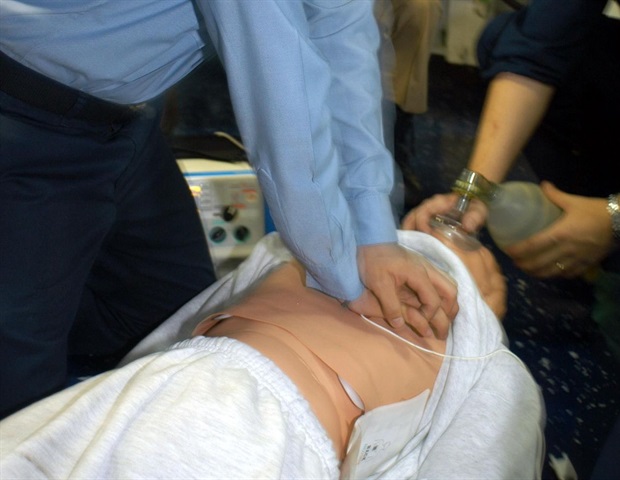
Desai Sethi Urology Institute brings renowned thought leaders to Miami Beach.
From urologic cancers to female urology to male infertility to kidney stones and sexual health, top urologists from throughout the nation shared their insights and practical tips at “Urology on the Beach,” a conference hosted January 13-15 by the Desai Sethi Urology Institute at the University of Miami Miller School of Medicine.
More than 150 specialists and general urologists, fellows, and residents attended the institute’s inaugural in-person conference at the Fontainebleau Hotel, learning from recognized leaders in a wide range of disciplines and enjoying the institute’s hospitality. Sylvester Comprehensive Cancer Center at the Miller School was a platinum sponsor, while Axonics, Inc., Boston Scientific, and Medtronic were gold sponsors and Focal One was a silver sponsor.
Our conference brought together world-renowned thought leaders in all aspects of urology. With its intimate setting, the conference provided three days of opportunities for residents, fellows, and professionals to network and have one-on-one discussions with our distinguished speakers.”
Dipen J. Parekh, M.D., conference chair, founding director of the Desai Sethi Urology Institute and chair of urology at the Miller School
In addition to faculty from Desai Sethi, conference presenters came from the Mayo Clinic, Fox Chase Cancer Center, Johns Hopkins, UCLA, New York University, Duke University, Mount Sinai, Dana Farber Cancer Institute, Vanderbilt University, University of Washington, and other academic medical centers.
Presenters shared the latest knowledge on topics spanning urologic oncology in prostate, renal, upper tract, and bladder cancers from experts at Sylvester, part of UHealth, as well as benign disease processes including male and female reconstructive surgery and male infertility/andrology. Other sessions focused on health disparities and career development.
“Urology on the Beach gave general urologists a chance to hear from top specialists about diagnosing, treating and managing patient conditions they see frequently,” said conference course director Bruno Nahar, M.D., urologic oncologist at Sylvester and assistant professor of urology. “For instance, our institute takes a multidisciplinary approach for treating advanced prostate cancers, and there are many new strategies that offer hope to patients and families. For low-risk cancers, we try to avoid unnecessary biopsies or treatments using imaging and biomarkers.”
Female urology issues, such as pelvic floor disorders, were highlighted in another conference session. “We have a great team of women urologists who collaborate on research as well as delivering the highest level of clinical care,” said conference course director Raveen Syan, M.D., assistant professor of clinical urology. “I think everyone who attended our conference came away with new knowledge.”
Kidney Cancer and Men’s Health
Urology on the Beach began Friday afternoon with a session on kidney cancer, as Miami urologist Vivek Venkatramani, M.D., moderated a panel discussion on challenging cases. Dr. Parekh then led a discussion on surgical innovation with semi-live surgeries.
Ranjith Ramasamy, M.D., associate professor of urology and director, reproductive urology, led the second session on male infertility, andrology, and men’s health. “The sexual health session focused on the latest advances in both male and female sexual dysfunction,” he said. “Our speakers discussed current treatments to manage erectile dysfunction and infertility as well innovative future options.”
Urology specialist Libert Ramos, D.N.P., noted that advanced practice providers are an essential part of the men’s health care team, fostering independence and supporting patient satisfaction and outcomes.
Prostate and Testis Oncology
In an interactive Saturday session, Dr. Nahar presented a healthy 53-year-old male’s intermediate prostate cancer case and asked attendees whether focal therapy or surveillance was the best approach. After a discussion of further tests or imaging, the consensus was to encourage the patient to seek treatment. Associate Professor of Urology and member of Sylvester, Sanoj Punnen, M.D., noted that the institute’s Miami Active Surveillance Protocol provides insights as to which patients are more likely to progress to advanced prostate cancer.
Jim C. Hu, M.D., M.P.H., director of the LeFrak Center for Robotic Surgery and the Ronald P. Lynch Chair in Urologic Oncology at Weill Cornell Medicine in New York, led a panel discussion on surgical innovations in prostate cancer. “Our goal is to cure cancer first, then maintain continence and potency,” said Dr. Nahar, who discussed the “modified hood” surgical approach.
Neeraj Agarwal, M.D., professor of medicine and a Presidential Endowed Chair of Cancer Research at the Huntsman Cancer Institute, University of Utah, provided an update on clinical trials for treating metastatic prostate cancer, and Joel Sheinfeld, M.D., testicular cancer specialist at Memorial Sloan Kettering Cancer Center in New York, gave an update on managing seminoma, a malignant germ cell tumor.
Ian Thompson, M.D., a prostate cancer specialist in San Antonio, Texas, and member of the National Cancer Institute’s Board of Scientific Advisors, gave a virtual presentation on “Three Studies that Changed My Practice.” He cited research that shows earlier detection for metastatic disease and longer survival rates should be considered when reviewing treatment options.
Health Disparities
Despite advances in recent decades, Black men continue to have a higher incidence and mortality rate from prostate cancer than other races, and Hispanic men have higher rates of testicular cancer -; two of the health disparities outlined in a session led by Leslie Deane, M.D., M.S., chief of urology service, Miami Veterans Affairs Medical Center.
Yaw Nyame, M.D., assistant professor of urology at the University of Washington in Seattle, noted that “race” is a social economic and political construct, and health disparities are often due to an individual’s living and environmental conditions. “We need to look at how we serve marginalized populations, including individuals with disabilities and mental health issues, as well as the LGBT community,” he said. “A patient- and community-centered approach is the key to delivering equitable care.”
Ekene Ada Enemchukwu, M.D., M.P.H., assistant professor at Stanford University, cited research conducted with Dr. Syan on disparities in care for Black women with urinary incontinence or pelvic floor disorders. “Patients with navigators through the health system were more likely to follow through with their care,” she said. “Meanwhile, urologists should take the time to understand the barriers facing many minority patients and reach out to their primary care physicians to coordinate individual care.”
After speaking on “Disparities in Kidney Stone Care,” Kymora Scotland, M.D., Ph.D., assistant professor of urology and director of endourology research at UCLA in Los Angeles, highlighted the need for greater diversity in the medical workforce. “We have to reach out to our communities and get children interested in medicine at a young age,” she said. “That’s the best long-term way to grow our pipeline of providers.”
Career Development
Career development is in important topic for academic and clinical urologists, as well as trainees, according to Stacy Loeb, M.D., a prostate cancer specialist with New York University Langone Health. In her talk on “Marketing Yourself and the Role of Social Media,” Dr. Loeb noted the importance of setting goals and taking control of one’s professional narrative.
“Many patients choose their provider based on a physician’s digital presence,” she said. “If you are recruiting participants for clinical studies, medical students or trainees, a strong social media platform is also very important.”
Later in the session, Dr. Parekh moderated a panel discussion on “The Path to Leadership in Medicine.” Asked whether leaders are “born or made,” the panelists agreed that the right skills can be learned, regardless of one’s innate personality. “Seek out mentors, including those outside medicine, who can provide you with good feedback,” said Dr. Parekh. “And remember that you can be a leader without a title.”
Female and Male Urology
Katherine Amin, M.D., and Laura Martin, D.O., assistant professors of urology, took part in a panel discussion on “Updates in Management of Stress Urinary Incontinence.” Victor Nitti, M.D., professor of urology at UCLA Health in Los Angeles, then gave a keynote talk on the “Case-Based Approach to Midurethral Sling Placement versus Urethral Bulking Agent.
Miami urologist Hemendra Shah, M.D., and Robert Marcovich, M.D., associate professor of urology and resident program director at the institute, moderated a session on “Benign Prostatic Hyperplasia/Endo,” including a panel discussion of minimally invasive surgical therapy in BPH.
On Sunday morning, Chad Ritch, M.D., M.B.A., associate professor of urology and member of Sylvester, moderated a session on “Urology Oncology: Bladder and Upper Tract” that included a panel discussion on the management of upper tract urothelial carcinoma.
Clinical instructor Archan Khandekar, M.D., and urologist Helen Hougen, M.D. led a tumor board multidisciplinary discussion of common genitourinary malignancies. In the final session, North Carolina urologist Aaron Lentz, M.D. gave a keynote talk on “Management of Male Incontinence,” followed by a panel discussion of difficult scenarios.
Reflecting on lasting impact of Urology on the Beach, Dr. Nahar said, “Our conference echoed the mission of the Desai Sethi Urology Institute to attract top talent, accelerate innovative approaches, and foster collaboration between specialties like basic and translational sciences, biomedical engineering, and technology.”
Source:
Desai Sethi Urology Institute at the University of Miami Health System







